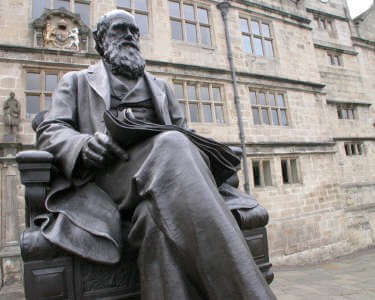The Origin of Humanity
Although Darwin carefully avoided humanity’s start in The Origin of Species, he detailed it in The Descent of Man. He speculated that, like all species, humanity evolved. “In a series of forms graduating insensibly from some ape-like creature to man as he now exists, it would be impossible to fix on any definite point when the term ‘man’ ought to be used.”
Darwin interpreted humanity in a fully materialistic fashion. According to this view, all of human nature, not just humanity’s physical makeup, emerged through natural selection. Lacking direct evidence, Darwin argued that humans must have evolved from an apelike animal based on anatomical comparisons and embryological similarities among man and other mammals.
By then, paleontologists had discovered 35,000-year-old Cro-Magnon fossils. But these human remains and the first Neanderthal specimen discovered in 1856 did little to support Darwin’s theory.
The first so-called ape-human intermediate interpreted from the fossil record wasn’t discovered until 1890, in Java, Indonesia. It became known as Homo erectus.
In 1924, anthropologist Raymond Dart uncovered a small skull interpreted to have a blend of ape and human features that appeared to be humanity’s most primitive predecessor. This fossil, nicknamed the Taung child, was formally classified as Australopithecus africanus. In the early 1960s Louis Leakey unearthed the first Homo habilis specimen in east Africa. Paleontologists considered this species (the first to use stone tools) to be the connection between the more primitive apelike australopithecines and Homo erectus.
Then the floodgates opened. In the ensuing decades, paleontologists unearthed many hominid fossils that encompassed a wide range of species and accompanying archeological remains. Each new hominid appeared to fill in the evolutionary tree and clarify the pathway that human evolution took over the last 6 million years.
But some of the most recent advances related to hominid-human relationships raise questions about evolution’s validity. In 1997 fragments of Neanderthal mitochondrial DNA from a 40,000- to 100,000-year-old skeleton were found in West Germany. When scientists compared them with the corresponding fragment of human DNA, the researchers discovered that Neanderthals made no contribution to human genetics.
Indirect genetic comparisons now eliminate Homo erectus from human ancestry also. The discoveries of new fossils caused evolutionary biologists to eliminate “Lucy” (Australopithecus afarensis) and the Taung child from the human evolutionary lineage. The last few years have forced evolutionary biologists to completely abandon the traditional view of human evolution presented in biology textbooks.
Scientific consensus confirms that humanity originated about 100,000 years ago in east Africa near the location ascribed to the Garden of Eden. Mitochondrial- and Y-chromosomal DNA markers trace that origin back to one man and one woman. Also, this research indicates that humanity migrated around the world from in or near the Middle East.
Referred to as the Out-of-Africa hypothesis by evolutionary biologists, this account of humanity’s origin appears to be simply an awkward attempt to force the biblical model into an evolutionary framework. If humanity’s genesis happened as Scripture describes, genetic diversity patterns should be identical to those observed. Science attests to a real Adam and Eve who gave rise to all humanity.
So, why then would so many people, especially scientists, celebrate Darwinism? Part of the reason has to do with the Christian approach to these matters. Often Christians are quick to point out the many problems. Rightly so. But merely explaining the difficulties isn’t enough.
In The Triumph of Evolution and the Failure of Creationism, paleontologist Niles Eldredge explains that creation scientists have not managed to come up with even a single intellectually compelling, scientifically testable statement about the natural world. So there is as little of substance in the scientific creationists’ treatment of the origin and diversification of life as there is in their treatment of cosmological time.
He goes on to complain that creationists refuse to pose testable hypotheses or make predictions worthy of science. Instead they devote their efforts to “attacking orthodox science” to establish “the truth of their own position.”
To be taken seriously, Christians must present a positive case for creation and offer scientifically testable ideas. Many scientists and scholars have been involved in developing a biblically based creation model-one that makes predictions so the creation theory can be compared with new discoveries and scientifically tested.
Presenting the biblical account in the form of a testable model provides a powerful and exciting new approach to evangelism and apologetics. Not surprisingly, many recent scientific discoveries validate the biblical description of the origin and history of life. In sharp contrast, the most recent scientific data contradicts the predictions motivated by Darwin’s ideas. If only he had known.
Fazale Rana, PH.D., is the vice president of science apologetics for Reasons to Believe and author of The Cell’s Design. He is an award-winning researcher, who also co-authored, with Hugh Ross, Origins of Life and Who Was Adam? Hugh Ross, PH.D., is the founder and president of Reasons to Believe. His latest of many books, More Than A Theory, reveals a testable model for creation.














































